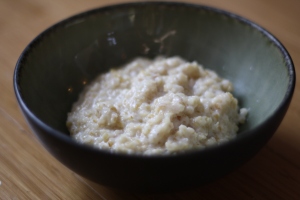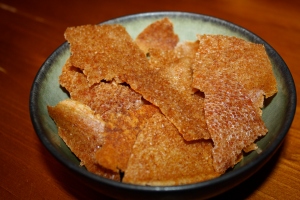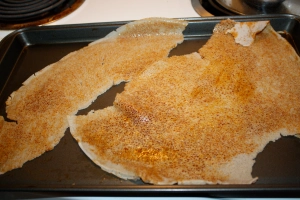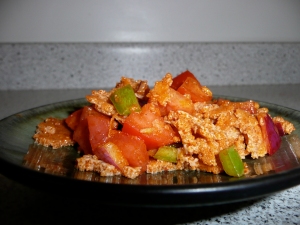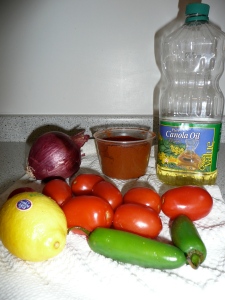I saw this article in the New York Times a couple months back about making one’s own yogurt and I have to admit that my first thought was *WHY*? Why would you do something so silly when you can just BUY yogurt everywhere? But then I saw this article in Slate comparing cost and time effectiveness of homemade versus storebought versions of several basic foods, including yogurt. My curiosity was piqued when I noted the cost comparison the Slate tester offered: $1.75 for a quart of “ambrosial” yogurt made from scratch, compared to at least $2.50 for an “insipid” factory-produced quart. All three of my kids love and eat yogurt every day, and we were spending a ridiculous amount of money on yogurt. So utterly ridiculous that I can’t even admit the total here. But let’s just say that my little ones’ fondness for the low-sugar organic Stonyfield farms six packs of teeny-tiny yogurts was costing us a pretty penny. And I didn’t like giving Dawit (or Bo and Sula) the regular kind, either, because it is just loaded with sugar. It was time to try something new.
But before I get into that, I want to make acknowledge Barbara Ehrenreich’s latest piece in the New York Times, “Too Poor To Make the News.” Ehrenreich (author of Nickel and Dimed– read it if you haven’t already) notes the latest media trend of focusing on the “hardships” faced by the middle and upper classes in this current economic climate- people forced to give up their private jets, their private Pilates classes, or their evenings out at Applebees. While it’s all fine and good for those of us in the middle to pinch pennies by growing our own tomatoes or making our own yogurt, it’s not exactly the same thing as living in a one-bedroom apartment with five other family members and subsisting on squirrel and raccoon for dinner. The media ignores those stories and in general, the people who live them, choosing to focus on hipsters riding their bicycles to work or housewives baking their own bread to save a few dollars here and there. I just want to acknowledge those folks living around us in this country who would love to have the problem of stressing about buying organic yogurt for their kids. I’m grateful that I can sit here and muse about the benefits of homemade yogurt instead of worrying about where our next meal will come from- and I don’t want to make it seem like we have been spared from serious hardship by taking measures like this when in fact our relatively “easy” lives have been made possible by a variety of social, educational, and racial privilege.
Anyways…onto the yogurt. I was so suspicious of the idea of making yogurt because I had just never even known that it was something you could do yourself. If you look at a yogurt container, it always lists ingredients that I would never mess with at home- stabilizers or pectin or preservatives. As it turns out, the ingredients of homemade yogurt are….drumroll please…milk and yogurt (for starter bacteria). That’s it. As Jennifer Reese wrote in the Slate article, “The first time I watched this metamorphosis, I felt like a sorcerer.” It is AMAZING. And the taste is so much better than regular yogurt- smooth, with no tangy sour taste that needs to be covered up with sugars and flavoring.
Here’s what you need:
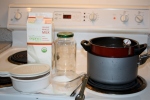
Yogurt supplies
–One quart of milk: I use whole, organic milk, purchased at BJ’s for $3.19/half gallon. I’ve made it with regular whole milk before and was not quite as pleased with the results, but if you live somewhere where you can’t get organic milk for a reasonable price, buy regular instead. I haven’t tried it with lowfat milk and probably won’t because we like the whole milk variety for its thickness, but if you poke around online, you’ll find that others do it with lowfat.
–Two tablespoons of plain yogurt like Dannon All Natural. After you make it once, you can use your own yogurt as the starter if you’re not an idiot like me who forgets to set some aside before adding flavoring.
–A thermometer: I use one that I had for making steamed milk for lattes, but any candy/ meat/ cooking thermometer that measures between 100 and 190 farenheit will do.
–A double broiler: don’t overthink this if you don’t have one. Any pot that fits in another pot (as pictured) will do.
–Glass or ceramic jars or containers with lids to put the yogurt into while it sets. You can put it into plastic/Tupperware after it’s finished, but in general I’ve been staying away from heating plastic with food so while the yogurt is kept warm I use a glass tomato sauce jar and a ceramic dish with a lid.
–Flavorings: I’ve used jam, honey, maple syrup, and vanilla in a variety of combinations. Next time I might try chocolate syrup. Be creative!
Preparing the yogurt:
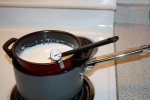
Heating the milk on the stove
-Begin by taking your “starter” yogurt out of the fridge and letting 2 tbsp. of it sit on the counter to warm up. Adding hot milk to cold yogurt can do some funny things to the texture.
-Bring water to boil in your larger pan and turn it to medium/high. Pour four cups of milk into the smaller pot and place it into the larger pot. Be sure to put in your thermometer to keep track of the temperature (it needs to get to 180-190 degrees).
-While the milk is heating, set up a shallow “ice bath” in your sink. If you don’t have ice, just cold water is fine. You’ll use it to cool down the milk more quickly later on. If you want to, you can skip this step and let the milk cool down on its own, but I do this to save time.
-Turn on your oven to “warm”. When it gets there, turn it off and open the door to let some of the heat out. This is where the milk will be sitting for the next few hours.
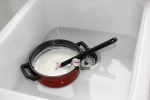
Milk in cold water bath
-As the milk heats up, stir as you wait for it to reach 180-190 degrees. When it gets there, remove the milk from the heat and place the pan in the cold water bath as shown. The milk needs to be at 120 degrees or less before you put it into the jars.

Mixing the starter with the warm milk
-When the milk has cooled to 120 degrees, add a few spoonfuls to the starter yogurt and mix thoroughly. I do this in a bowl with a spout and then add the rest of the milk so that it pours into the jars more easily, but it really doesn’t matter what you do it in as long as you do it separately from the rest of the milk.
-Pour the milk (that has now been combined with the starter yogurt) into the jars or containers you will be using and put on the lids.

The yogurt bundled up in the oven.
-After your milk is in the jars, wrap them in towels and place in the oven with the light on. The yogurt needs to be kept warm (BUT NOT HOT) for the next five or so hours.
-Now for the hard part: just leave the yogurt alone. I always want to peek, or tilt the jar around to see if it’s firmed up yet. Don’t do it- it can mess up the texture of the yogurt or make it take longer. If you want to check, open up the oven and touch the jar just to make sure it’s still warm.
-I leave it for about five to six hours. When it’s ready, there should be a liquid layer that has separated from the yogurt (and don’t be alarmed if it’s yellowish-green, it’s just whey). Drain that and either leave the yogurt in the jars or spoon it into different containers you want to keep it in for serving. SET SOME ASIDE AS A STARTER FOR YOUR NEXT BATCH NOW before adding flavoring. Otherwise, you have to buy another container of plain yogurt as starter the next time you make it.
-If you want, add flavoring. The yogurt is naturally much, much sweeter than storebought so make sure you try it before you start messing around with it. Since it doesn’t have the mouth-puckering sourness of regular yogurt, you need very little maple syrup, honey, jam, sugar, etc. to sweeten it.
-Refrigerate before eating.
At $3.19 for a half gallon of milk, this works out to $1.60 for a quart (4 cups) of the most amazing, organic yogurt that you have ever tasted (not counting the pennies it costs to add some jam or honey to it). That’s $.40/cup. Compare that to the $4.69 our local grocery store charges (it’s slightly less at Trader Joe’s, but they only carry one variety) for the six-pack of 4 ounce Stonyfield Farms YoBaby organic yogurt, which is the equivalent of $1.56/cup, almost four times as expensive as the homemade. Plus, by having the kids pitch in to help make it, I’ve gotten them super enthusiastic about eating it. Bonus.

